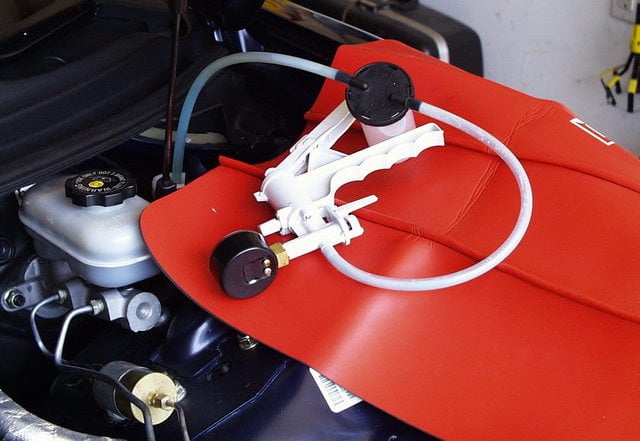Sometimes air can get trapped within the clutch’s hydraulic system. When this happens, you may encounter symptoms such as:
- Change in pedal travel
- Clutch doesn’t fully disengage
- Soft or spongy feeling clutch pedal travel
When there’s air in the system, the hydraulic fluid may not fully actuate the slave cylinder to completely disengage the clutch. This causes two problems that can become expensive:
- The clutch friction material is always slightly rubbing on the flywheel when you are stopped. This can cause the friction material to wear out quickly, leading to a premature clutch replacement.
- Because the clutch doesn’t fully disengage, some power is traveling into the transmission during shifts. This causes wear on the synchros and the gears in the transmission.
Either problem can cost thousands of dollars to fix. That’s why you need to bleed your clutch as soon as you figure out that air is trapped within the hydraulic system.
What Does It Mean To Bleed Your Clutch?

Bleeding the clutch simply means removing the unwanted air that is trapped in the clutch’s hydraulic system. There are three different ways to do this. Here is a quick summary of each method:
1. Manual Clutch Bleeding Process
One person pumps the clutch pedal while a second person opens and closes the clutch bleed valve.
2. Pressure Process
A pressure bleeder attaches to the clutch master cylinder, and pressurizes the hydraulic system. It pushes hydraulic fluid into the clutch master cylinder. This process is done as a person opens and closes the clutch bleed valve at the slave cylinder.
3. Vacuum Process
A vacuum bleeder attaches to the slave cylinder bleeder valve, and pulls fluid from the clutch master cylinder. Next, it draws and traps both fluid and air into a stand-alone vessel.
Fortunately, bleeding a clutch is a simple process. Since you can do it without a helper, we’ll show you how to do the job with a pressure bleeder.
The Tools You’ll Need

First you’ll need a few things:
- A pressure bleeder
- Flexible hose or tubing that will fit tight on the bleeder valve (clear tube is best)
- Cup or can to catch the fluid
- Jack and jack stands
- A wrench that fits the bleed valve. (These can be small.)
If you work on your vehicle often, a $50+ pressure bleeder (or vacuum bleeder) can be a worthwhile investment. You can also use it to bleed the brakes.
The Steps To Take
To bleed your clutch, take the following steps:
- Jack up the front of the car.
- Open the hood.
- Remove the cap from the clutch fluid reservoir. Make sure the reservoir is completely filled to the full line.
- Screw the pressure bleeder onto the top of the reservoir.
- Pump the clutch a few times.
- If using a power bleeder, watch the gauge and pump it to a PSI of about 12.
- Grab the following items and then go under the vehicle:
- Flexible tubing
- Cup
- Wrench
- Find the clutch slave cylinder, and locate the bleed valve. If it is corroded, spray it with some penetrating oil.
- Make sure you can turn the bleed valve.
- Place the hose over the bleed valve, and get the cup ready to collect fluid.
- Using the wrench, crack the bleeder valve open about a 1/4 of a turn and keep hold of the hose. Start watching for fluid and air bubbles.
- Wait for the air bubbles to stop. When they stop, tighten the valve and remove the tube.
- You should have lost very little fluid, but you should still top off the reservoir to the full mark.
- Test your clutch. It should feel tighter and easier to engage. If the spongy pedal returns quickly, you may need a new clutch master cylinder or slave cylinder.
Bleeding the brakes with a vacuum bleeder is just as easy. If you have more questions, take a look at your service manual or give us a call. We are always happy to talk brakes and clutches.




